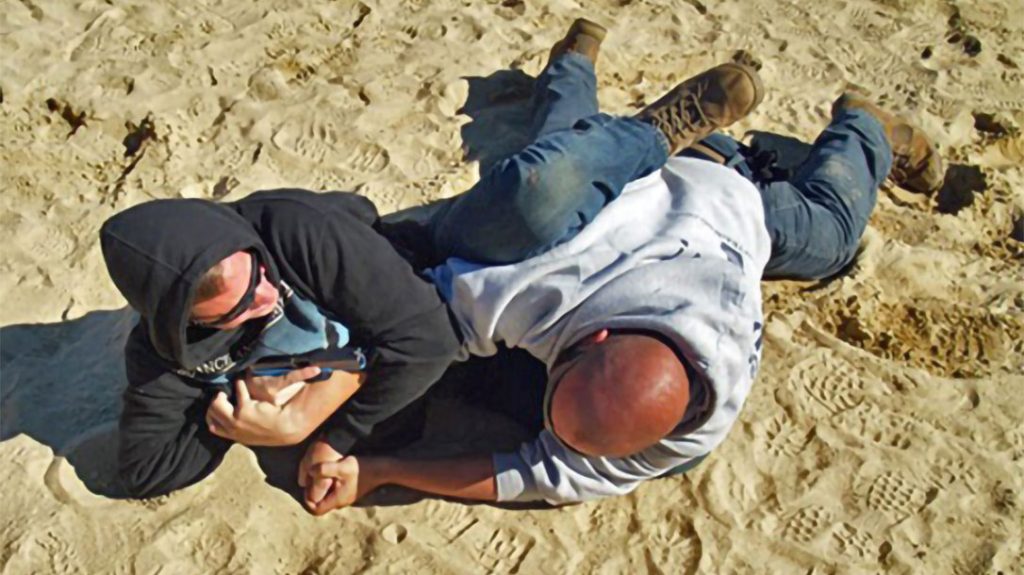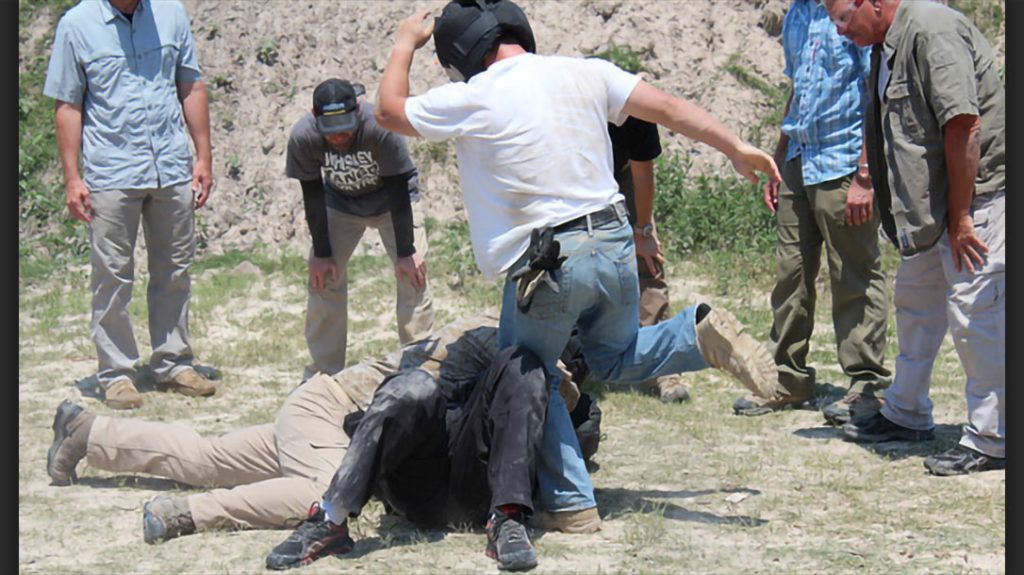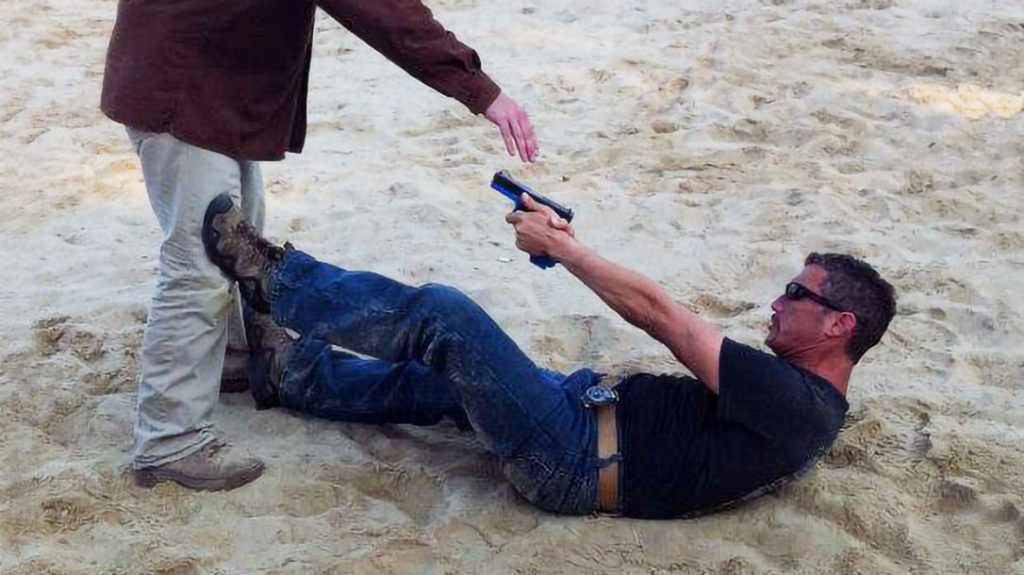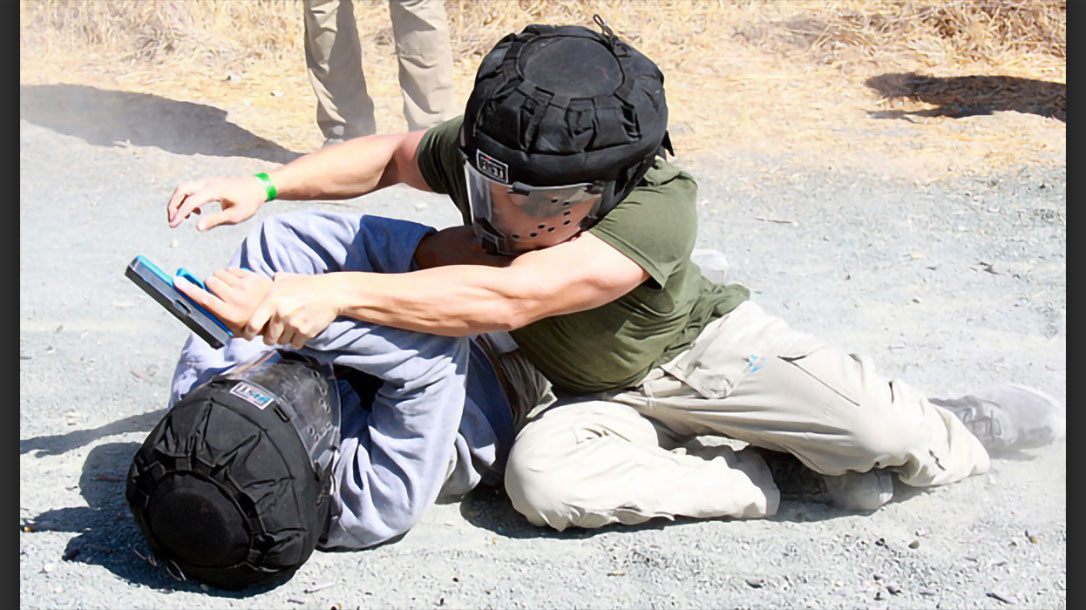It was the late 1990s, during the worst days of the crack cocaine epidemic in southern Mississippi. Violence across the region was near an all-time high. And Craig “Southnarc” Douglas found himself in a life and death situation, struggling over a gun inside a parked car. It was then that he learned that the need for close combat firearm retention techniques can happen anywhere, like a car or the ground.
A Good Ground Game Helps with Firearm Retention Techniques in Awkward Environments
An undercover narcotics officer doing a drug buy, Douglas was a lifelong martial artist, shooting enthusiast, and former Army Ranger. Despite all his prior training, when the drug buy turned into an armed robbery, he quickly realized he wasn’t prepared for the realities of close combat in such an odd environment.
It was not the first time Douglas had faced a gun-wielding robber.
Advertisement — Continue Reading Below
“I was robbed nine times over the years I did undercover work. And as strange as it sounds, most of them were just ‘business as usual’ robberies,” he said. “But this time, I don’t know what it was; something felt different.”
Douglas learned that in the majority of such robberies complying with the robbers was usually enough to end the encounter. However, on this occasion, he knew compliance wasn’t going to work. Instead, he lunged for the assailant’s weapon attempting a gun grab.
This led to a fracas that saw him wedged down in the car with his assailant on top of him. During the struggle, the attacker was able to fire a single shot. The shot missed Douglas’ head before he was able to wrestle the gun from him. He still suffers some hearing impairment from the incident.
Advertisement — Continue Reading Below
There were no fancy Hollywood gun disarms. Douglas simply held on to the shooter’s hand for dear life, trying to maintain control. He bent it between their bodies against the pillar of the car and used any method he could to dislodge the weapon. When he finally did, the assailant ran, leaving Douglas to question the efficacy of everything he’d ever learned about self-defense.
Training for Firearm Retention in Real Life
It was not the only incident in his career that convinced Douglas—now one of the world’s leading defensive tactics instructors for hand-to-hand combat involving weapons—what he’d been taught in both martial arts classes and on shooting ranges wasn’t necessarily what worked in real life.
“A lot of the things I learned were never pressure tested or constructed for the environments I found myself working in,” he said.
Advertisement — Continue Reading Below
Indeed, locations like car interiors aren’t where you typically find self-defense training conducted. Besides which, hand-to-hand combat and shooting have traditionally been taught as separate subjects. But Douglas learned, through hard experience in law enforcement, how often these realms can intersect.

He left undercover work in 1998, becoming a training officer for his department. He then began experimenting to discover what actually worked under practical conditions.
Advertisement — Continue Reading Below
“These were tactical problems no one had addressed before. So, I had to start from ground zero with some young police officers who volunteered to put on motorcycle helmets and MMA gloves and use guns with marking cartridges to go at it,” he said.
Though others have used dummy guns for extreme CQB training, Douglas believes he was the first to do it with guns capable of firing marking cartridges. This is likely because the manufacturer specifically warned against using these cartridges inside of three feet. But this is the range where Douglas was finding violent encounters most frequently occurred.
Finding a New Combat Discipline
After several years of experimentation, Douglas jettisoned most of his traditional martial arts in favor of techniques borrowed from combat sports like boxing, Brazilian jiu-jitsu, and, most importantly, wrestling. Wrestling, he believes, offers the best avenue for controlling where a fight will end up. Whether that’s standing or on the ground.
Advertisement — Continue Reading Below
Ground work and ground firearm retention techniques are things Douglas has become especially noted for. Perhaps simply for the oddity of seeing people in his courses rolling around on the floor trying to draw guns and shoot each other with marking cartridges. The training often involves punches, chokes, and multiple attackers playing a role (pro tip: get a really good retention holster).

To be sure, this is just one aspect of what he teaches. Douglas places far more emphasis on what he calls “deselecting” yourself from violence through a combination of awareness, verbal agility, and social skills that allow for avoiding altercations before they turn physical.
Advertisement — Continue Reading Below
And despite being known for groundfighting with weapons, Douglas admits that staying off the ground in a violent confrontation is almost always the best option. He finds there is one common problem, particularly when it comes to weapon retention and being taken down. That is, people trying to immediately draw their gun at close quarters rather than first neutralizing an attacker’s grab or strike.
It’s one thing to practice your quick draw against a shot timer. But it’s quite another to do it when someone is trying to body slam you.
Training for Ground Combat
But Douglas likes to prepare for worst-case scenarios. He believes anyone seeking an introduction to practical combat at close range should start with training for some ground fighting. This is because the experience of fighting in a horizontal position is so counter-intuitive.
Advertisement — Continue Reading Below
While he likes Brazilian jiu-jitsu for developing those basic ground skills, he said that what he actually teaches when it comes to fighting with weapons on the ground is sometimes the opposite of what you might find in jiu-jitsu. In jiu-jitsu, you usually seek to stay close to an opponent. But when looking to deploy a weapon or just get back to your feet, you need to create space.

To do this, Douglas suggests using your legs to keep an opponent off you and provide room. On the other hand, when dealing with someone who is attempting to draw a weapon against you, you’d try to deny them that space by staying as close as possible.
Advertisement — Continue Reading Below
“Ultimately, I like to teach people to be able to problem solve. A gun can be an awesome problem-solving tool within a tiny framework of situations,” said Douglas. “But if some panicked, autistic kid comes running up and startles you, he doesn’t need to have a gun drawn on him. Something like restraining him with a wrestling tie-up and asking if he’s okay is a far better solution.”
To learn more about Craig Douglas and his training programs, visit Shivworks.com.
























